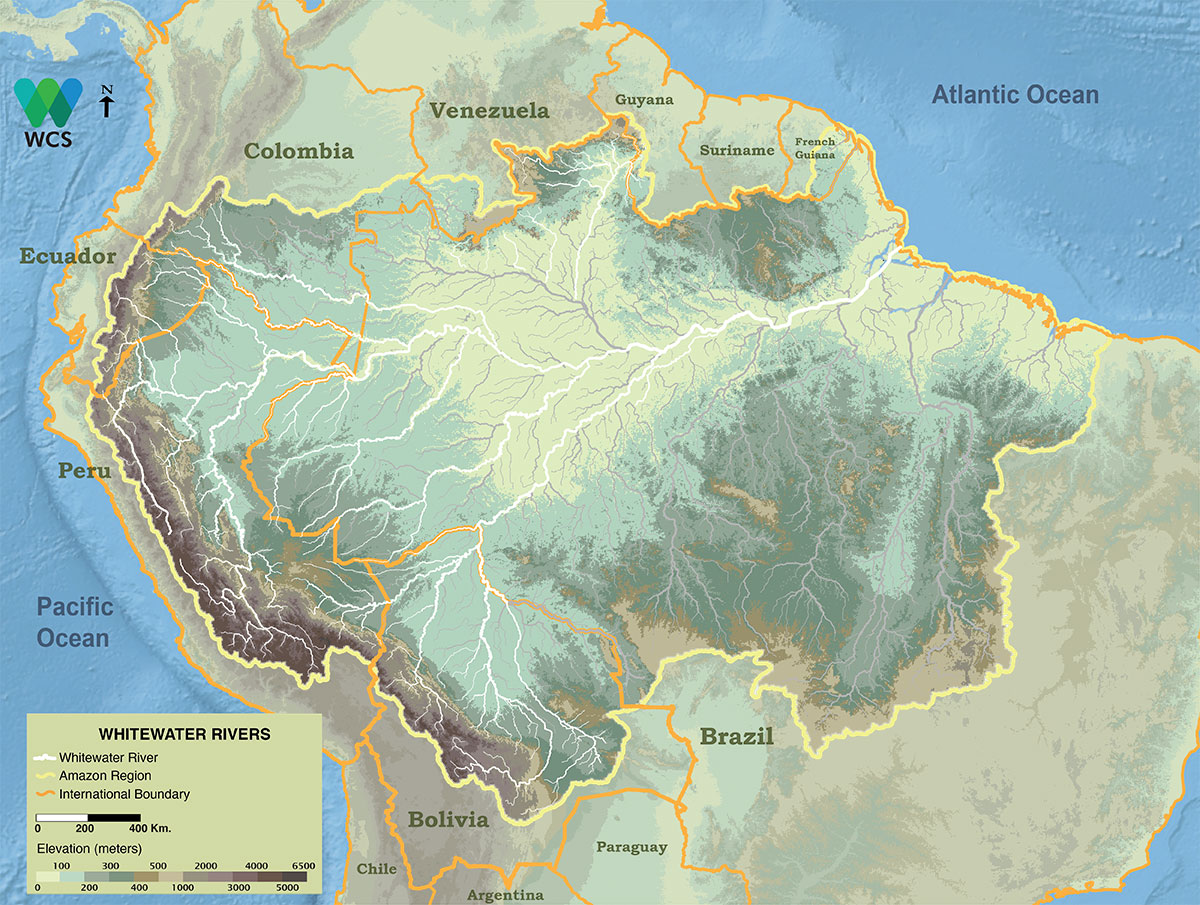
Map: Wildlife Conservation Society, 2016.
Whitewater rivers arise mostly in the Andes and are characterized by high turbidity and nutrient content. Because of the large number of headwaters in the Andes the Amazon River is rendered a whitewater river.
When a river transports large quantities of sediments it is usually rendered “muddy,” a color somewhat similar to coffee with milk. Major tributaries with headwaters in the Andes are all turbid because of the huge amount of loose material in the high mountain chain that is easily eroded and then carried downstream as far as the Atlantic Ocean. Locally, these rivers are often referred to as whitewater rivers, though the term should not be confused with its English interpretation that can also refer the turbulent waters of rapids. These tributaries include the Madeira, Ucayali, Marañón, Putumayo-Içá and Caquetá-Japurá rivers. There are also several tributaries that do not have headwaters in the Andes but are also considered whitewater rivers because of their relatively high sediment loads, such as the Purus and Juruá. Whitewater rivers have a higher nutrient content than the blackwater and clearwater rivers. The pH of water in turbid rivers is often near or above neutral (7.0). At elevations higher than approximately 2,000 m in the Andes, the pH of river water can be above 8.0.
-

Aguas Blancas 3
The Madeira River is one of the two most important contributors of sediments to the Amazon River. Department – Country: Roraima – Brazil Main Basin – Sub Basin: Negro – Branco Main Stem Elevation: 83 Photographer: Michael Goulding
-

Aguas Blancas 4
Surface view of the confluence of the Amazon and Negro rivers, with Manaus in the background. Complete mixing of the Negro only takes place many kilometers downstream. Department – Country: Pará – Brazil Main Basin – Sub Basin: Amazon Main Stem – Eastern Amazon Main Stem Elevation: 32 Photographer: Michael Goulding
-

Aguas Blancas 5
The most striking contrast in water types can be seen at the meeting of the whitewater Amazon River (Solimões) and blackwater Negro River near Manaus. This image is looking east and downstream. Photographer: Luiz Claudio Marigo
-

Aguas Blancas 6
Department – Country: Amazonas – Brazil Main Basin – Sub Basin: Madeira – Madeira Main Stem Photographer: Luiz Claudio Marigo
-

Aguas Blancas 7
Department – Country: Amazonas – Brazil Main Basin – Sub Basin: Amazon Main Stem – Eastern Amazon Main Stem Photographer: Luiz Claudio Marigo
-

Aguas Blancas 8
Department – Country: Amazonas – Brazil Main Basin – Sub Basin: Negro – Lower Negro Main Stem Photographer: Luiz Claudio Marigo
-

Aguas Blancas 9
Department – Country: Amazonas – Brazil Main Basin – Sub Basin: Negro – Lower Negro Main Stem Photographer: Luiz Claudio Marigo
-

Aguas Blancas 10
Department – Country: El Beni – Bolivua Main Basin – Sub Basin: Madeira – Mamoré Photographer: Luiz Claudio Marigo

